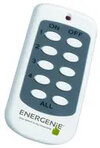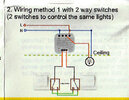- Joined
- 27 Jan 2008
- Messages
- 27,454
- Reaction score
- 3,320
- Location
- Llanfair Caereinion, Nr Welshpool
- Country

I have also never seen it before, and I must log that one into memory, thank you.

I have also never seen it before, and I must log that one into memory, thank you.
Fancy logging this one too using one SPDT and two DPDT switches. I've shown it as multicoloured wiring but it was failed and shorted brittle red rubber. Initially I didn't know what it was supposed to be doing other than being told it doesn't switch off, and the person telling me didn't know there were 3 switches.I have also never seen it before, and I must log that one into memory, thank you.

You are obviously correct but why would anyone do that when using an intermediate switch?The only thing odd about it is the position where the joint is made for the 'conventional method' of 2 way switching.
If it where drawn like this View attachment 330311 with the red terminated in a different random terminal (let's call it a wago or 'N LOOP') and treat the rest as a 2 way switch, would there be any difficulty understanding the operation?
Isn't the wiring between the switches in both systems referred to as "strappers" in the UK?(The [North American] "Traveler System" is referred to as a "Strapper System" in the UK.
According to your diagram, it is the "conversion" method.What would the "California System" be called in the UK?
YesIsn't the wiring between the switches in both systems referred to as "strappers" in the UK?
Having worked under so many different conventions of drawings it's not very often I struggle. Sometimes locations confuse, it may be Erics where the supply and lamp are curled round under the switches and initially it was not obvious which parts are to be cables.According to your diagram, it is the "conversion" method.
View attachment 330408
I dislike these diagrams which mark connections in apparently random and inconsistent positions; Eric frequently uses them; where do they come from?
on the ground the symbols are incorrectly drawn as the wires/connexions should always run away from the device:
It maybe but I still come back to this similarity:Surely it is more likely the result of a DIYer's random trial and error efforts which happened to work.
yes, In my home I have conventional and conversion methods including the version branched at the rose in #23.Lighting circuits can cause confusion, even for the more knowlegeable too. Because there are so many variations of combinations that will actually work. And in some installtions the same person or different persons might have adopted different variations in different places too.
Therefore, you sometimes needs your wits about you to enable you to have a clue what`s going on.
Plenty of room for incidental errors to creep in.

 and I still use this today, although can also use voice commands.
and I still use this today, although can also use voice commands. as the remote control, however wife preferred voice with the Nest Mini's we have, so the button reused as a door bell.
as the remote control, however wife preferred voice with the Nest Mini's we have, so the button reused as a door bell. so have best of both, two way switches and voice control, plus of course can use the phone, but this is mainly just for visitors, we rarely use the switches, and one starts to wonder why we still need to wire in intermediate switches?
so have best of both, two way switches and voice control, plus of course can use the phone, but this is mainly just for visitors, we rarely use the switches, and one starts to wonder why we still need to wire in intermediate switches? hee-hee, ha-ha.
hee-hee, ha-ha.If you need to find a tradesperson to get your job done, please try our local search below, or if you are doing it yourself you can find suppliers local to you.
Select the supplier or trade you require, enter your location to begin your search.
Are you a trade or supplier? You can create your listing free at DIYnot Local
